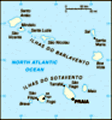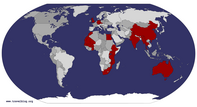Advertisement
Published: June 13th 2007

 Africa em Portugues
Africa em Portugues
A colourful map on a school wall in the Vale do Paul
Tom Griffith
Festa! Cape Verde, like most isolated micronations, is a pretty bloody weird place. It is not exactly a tourist mecca, lying out in the middle of the Atlantic Ocean and coming somewhere slightly above Burkina Faso in the,'Where the hell is that?' stakes. In fact, I'd barely heard of it until we saw it in the West Africa Lonely Planet and thought it might be a nice place to visit, if we ever had the time, the inclination, the money... which we realised we did have, once we met a friendly American couple at the Senegal-Mauritania border who had been to the archipelago, and raved about it.
After leaving Saint Louis, we headed down the Senegal coast to Dakar, the chaotic and edgy capital city. It wasn't as awful as I had feared, but there isn't too much to recommend it, unless you like massive African cities full of poverty and government buildings. We stuck around for about a day, just long enough to grab a Cape Verdean visa, and dodge the thieves, and book a flight to the island nation.
So, after four days in Senegal (we will be returning, and hopefully spending another couple of weeks there),

 Paul
Paul
The pretty village of Paul, on Santo Antaowe boarded a small plane bound for Praia, the capital city of this tiny nation. The country consists of ten islands that lie about 500 kilometres due west of Senegal, with an area of about 4000 sq km (bigger than Luxembourg, smaller than Brunei) and a population of about 450,000 (about the same as Tasmania). There are actually about a million Caboverdeanos around the world, but due to the crappy economic situation of the island, more of them live overseas than in their home country.
The place was uninhabited when the Portuguese arrived in 1456, but they stuck around and founded the first European city in the tropics. They started growing stuff (sugar cane for rum, mostly), but of course they didn´t want to get their hands dirty, so they grabbed a bunch of Africans from the mainland and brought them over as slaves. Over the years, the demographics took the usual Portuguese colonial path - intermarriage, leading to a mainly mestico (mixed European-African) population, who are overwhelmingly Roman Catholic, and speak Portuguese, or
crioulol, a Portuguese-African hybrid. There are still a few white faces around, mainly expat Portuguese who stayed after independence was granted in 1975, plus a

 Antao over Antao
Antao over Antao
A statue of Santo Antao looks down onto the island of Santo Antaoscattering of Macao Chinese (who run the discount stores, of course), and a few mainland Africans, especially Nigerians and Ghanaians, here for (depending on your source), the drug trade, or improved economic opportunities (which means selling belts and sunglasses in the streets).
Cape Verde has the highest standard of living in West Africa, and its high literacy rates and low infant mortality are spectacular compared to such nations as Mali or Niger. However, compared to Europe (to where many Caboverdeanos wistfully look, it seems), the place is still very poor - GDP is around $2,400, compared to $18,500 for the old colonial master, Portugal (those are the last figures in this post, I promise).
Cape Verde must be the most misnamed country in the world. It means, literally, Green Cape, but if you're thinking white sandy beaches, groves of palm tress, and verdant hills of lush vegetation, think again. Cape Verde is dry, barren, and arid, and consists mainly of brown hills and volcanic rocks. There is even a mountain called Monteverde which is basically just a huge, treeless rock - the name comes not from vegetation, but from the lichen that grows on it. The only island

 Caboverdean chicos
Caboverdean chicos
Three Cape Verdean siblings pose for a group photothat comes close to being green is Santo Antao, and even then the banana and sugar cane farms are limited to just a few fertile valleys.
The lack of arable land and of water is the basis of all Cape Verde's problems. The islands are overpopulated, and most of the nation's supplies have to be imported. This means food is pretty expensive, and most people subsist on cachupa, a stew of beans and corn, with maybe a sliver of pork thrown into the mix, if a pig happens to have been slaughtered in the recent past. For a national dish, the old cachupa is pretty hard to track down, and we would often walk into a restaurant, ask for a plate of the stuff, only to get a smirk and a reply of, 'no cachupa', as though the stuff was gold dust and we were stupid to even ask. At our hotel, we were told quite plainly that they had none, and then watched, stunned, as a table of Cape Verdean guests were served a huge steaming plate of the stuff. Eventually, we did find a place that sold it and didn't treat us like lepers for ordering it,

 The hard path
The hard path
The cobblestone path to the ridge of Cova crater, Santo Antaoso that became our restaurant of choice - until, inevitably, they had to tell us, sorry, no more cachupa for you.
Anyway - back to the problems of Cape Verde. Although things have come forward since the days when drought killed thousands of Caboverdeanos at a time, the economic situation here is still pretty hopeless. Most people have given up trying to scrape a living from the dry soil, and unemployment/underemployment is a real affliction here. This is why emigration is such an obsession, and why Cape Verdeans, despite a real love of their country, still want to get out and try their luck elsewhere. We realised just how bad the emigration situation is after talking with Manuel, a man in his 70s, who cornered us in a banana plantation and launched into a drunken rant about the current government. After telling us that life was better under the Portuguese, he informed us that he had 8 children (big families are another Cape Verdean obsession), and that 7 of those kids lived overseas.
Anyway, back to the trip. We arrived in Praia, the capital city, and found out at the airport that the next ferry to Sao Vicente,

 Farmhouse
Farmhouse
A small house sits among the banana trees of the Vale do Paulour preferred destination, was leaving in one hour. We took a ripoff taxi to the port, and just made it onto the boat. We hadn't had time to change money, but an enterprising Nigerian called Clement offered to exchange our Euros at a very poor rate - which got him some cash, and us some escudos to buy our tickets. A 17-hour hell journey followed, as we cruised across the Atlantic in the company of about 50 young men who had just finished their national service, and were returning to their home island after a two-year absence. They decided to spend the journey drinking grogue (the local firewater, made from sugar cane and appropriately named) and singing loudly. One guy even got locked in the brig by the captain after trying to pickpocket one of his own mates.
Eventually, we arrived in Mindelo, the main town on Sao Vicente. We knew we had arrived when the hungover national servicemen began chanting and hanging over the edge of the ferry.
Mindelo was a pleasant town of colonial architecture, with a few beaches nearby, and some laid-back locals getting around. I wasn't quite what we were after, though, so a

 Mindelo
Mindelo
A German car and a Portuguese building in Mindeloday or two later we pushed on to Santo Antao, supposed to be the prettiest of the Cape Verdean islands. We were not disappointed: soaring hills, beautiful valleys, lovely people. We headed straight for the village of Paul, a stunningly located place between the ocean and the hills. We spent a great 4 days there, hiking up the Vale do Paul, and along the coast, as well as sampling the local grogue and...yes, cachupa. We were lucky enough to be in the village when the annual Santo Antao festival started up. Basically, this is just a three-day long booze-up, and temporary bars get set up along the beach so people can get legless. Also, a few African-run stalls spring up, one of them selling the unusual combination of Jesus posters, and hard porn DVDs. The bars were pretty lax in their sale of alcoholic products - in fact, our chosen haunt just handed over the bottle of grogue when you ordered a shot, and told you to go for your life.
We left Paul this morning, after a sleepless night spent next door to a disco that shut down at 4am and started back up at 7.30. We have

 Cobblestone highway
Cobblestone highway
The highway across Santo Antao, which has offers spectacular views down from the hillsone night in the (currently) rather more peaceful town of Ribiera Grande, before pushing back on across the archipelago to Praia, for our return flight to Dakar...we are craving some real West Africa again, and we can't wait.
Tom and Suze's Top Five of Cape Verde
1. The amazing walk along the Vale do Paul. From the crashing ocean and palm trees of Paul, past sugar cane and grog distilleries, to the lip of Cova crater, the old volcanic heart of Santo Antao. Hard work but worth it.
2. Cachupa. Simple, but a hearty dish and very tasty if you can actually find it.
3. Santo Antao. The greenest island, with spectacular views and great walks. Two ferries away from Praia, but a worthwhile trip.
4. Vinho, cheese and ham. All those imported wines and foods from Portugal are a godsend after a few months in Africa.
5. The relaxed, easygoing lifestyle. This place is pure heaven after the chaos and hassle of West Africa.
Tom and Suze's Bottom Three of Cape Verde
1. The dry, barren landscape. Starkly beautiful in its way, but a tropical paradise it ain't.
2. The

 Grog!
Grog!
Me enjoying a glass of grogue, the local firwater made from sugar cane. A shot costs about 30 cents and you can get them everywhere, from the supermarket to tiny bars in the streetcost. Food and ferry travel are pretty expensive, and when you add on the airfare from Senegal, Cape Verde is a costly destination.
3. Having your life dictated by the ferry timetables. The only affordable way to get between the isalnds is by ferry, and sometimes they only depart once a week. Too bad if you arrive in a boring little town the day after the last ferry left...
***
Africa Country Count: 5
Cape Verde Overland Kilometre Count: 495km
Africa Overland Kilometre Count: 10,995km
Next Country: Senegal (again)
Advertisement
Tot: 0.285s; Tpl: 0.021s; cc: 12; qc: 37; dbt: 0.1928s; 1; m:domysql w:travelblog (10.17.0.13); sld: 1;
; mem: 1.2mb



























christy
non-member comment
Where are you from? You can get wonderful cachupa in the states Rhode island.....